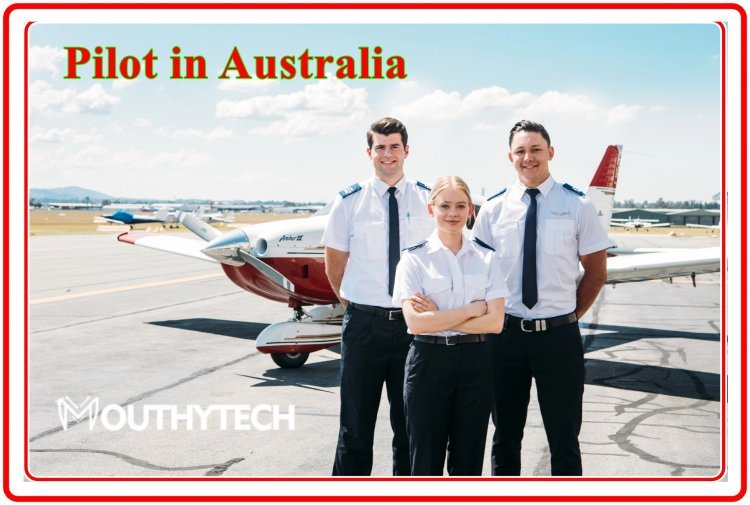The Ultimate Guide to Becoming a Pilot in Australia
You should be at least 18 years of age to obtain a commercial pilot license. Completing an integrated and non-integrated program is also mandatory for this. The integrated course contains 150 hours of flying, and the non-integrated course includes 200 hours of flying for the Aeroplan category rating.

The number of people taking flying lessons has increased by over 50% in the last decade, and those statistics don’t look like they’re going to be slowing down anytime soon! If you’re one of the many people who want to become a pilot, you’ve probably wondered how to go about it, how much it costs, and how long it takes. Unfortunately, there are no easy answers to these questions — as every piloting career path is different — but this guide will walk you through the steps of becoming a pilot in Australia so that you can get started!
How to Become a Pilot in Australia: The Ultimate Guide If you’re tired of life on the ground and dreaming of the wide open skies, it might be time to consider learning how to become a pilot in Australia! In this guide, you’ll find all the information you need about getting started as an aviation student in Australia, from choosing your flight school to learning about what equipment you’ll need and how to pass your training.
Choosing to become a pilot in Australia can be an exciting, rewarding, and lucrative career option. If you live in the country, it’s fairly easy to get your pilot’s license and work towards flying professionally or as a hobbyist. Follow these steps to learn how to become a pilot in Australia, whether it’s for work or fun!
who is a pilot
If you've ever dreamed of being a pilot, there's no better place to achieve your goal than Australia. With its vast expanses of open space and incredible scenery, becoming a pilot in Australia is the perfect way to see the country from a unique perspective. Plus, with its excellent training facilities and friendly aviation community, becoming a pilot in Australia is easier than you might think. So if you're ready to take to the skies, read on for our ultimate guide on how to become a pilot in Australia.
What does a pilot do?
Depending on what area of the industry they work in, a pilot may be responsible for transporting members of the military, civilians, commercial products, private goods, or other types of cargo. The type of aircraft they operate depends on their specialization. Some pilots fly large commercial aircraft while others fly helicopters. Other pilots fly cargo planes to transport large amounts of automobiles, mail, industrial equipment, and other products from one place to another.
The average salary for pilots
The average salary for a pilot in Australia is $75,796 per year. Pilots in Sydney, NSW, and Darwin, Northern Territory are some of the highest-paid professionals. Pilot salaries depend on various factors, such as their employer, the number of hours they work in a month, and geographical location.
How to become a pilot
Here are the steps to becoming a pilot in Australia:
Obtain your High School Certificate (HSC)
While there are no specific formal educational qualifications necessary to sit a pilot's license test in Australia, having a basic background in year 10 maths and physics can help you. There are also degrees and diplomas in aviation from Australian universities, which are not necessary to pass the license tests but may be beneficial when a chief pilot or airline company is reviewing your resume. No Australian airlines require a bachelor's degree but almost all require an HSC.
For a private pilot license, you are required to obtain a degree in aviation. If you ever want to fly for an airline company outside of Australia, such as the U.S., consider getting a university degree, which doesn't need to be related to aviation.
Do your research
There are different routes to becoming a pilot. It's advisable to understand what your options are before you learn to fly. Research all you can about flying or pilot training schools in your area and choose the one that best fits your needs. Each pilot school will have a primary focus, such as either commercial or private licensing, and will have different fees and costs associated with it.
Choosing the right pilot school depends on what your goal is. If you just want to fly for pleasure, then opt for a school that focuses on private or recreational licensing. However, if you aim to have a career as a pilot, look for a school that offers non-recreational commercial pilot training
What you'll need
To become a pilot in Australia, you'll need to complete an accredited aviation training program, obtain a private pilot license (PPL), pass a medical examination, and obtain a civil aviation authority license. You'll also need to have strong communication and navigation skills and be able to work well under pressure. If you're not interested in becoming a commercial airline pilot, there are plenty of opportunities for pilots to fly helicopters or airplanes for the military. Your income as a professional pilot can vary greatly depending on your level of experience and employer. A typical salary ranges from $55,000-$100,000 per year with added benefits such as free flights or discounts on holidays.
Complete your training
Complete your flight school training hours. It usually takes approximately 55 to 60 hours of training to qualify for a private pilot license. If you're training full time, this often takes about two months. If you are training part-time, it can take around a year if you train for just over an hour per week.
The exact length of time that you'll spend training varies depending on several factors, including the weather, your financial situation, aircraft availability, and how regularly you are flying.
Get an aviation reference number (ARN)
You can obtain an aviation reference number (ARN) from the Civil Aviation Safety Authority (CASA). CASA is a governmental organization that regulates and processes all aspects of aviation in Australia. An ARN is free to get and will take up to one week to process. When you are flying with an instructor, however, you don't need an ARN.
Obtain a CASA medical certificate to fly solo
To fly solo, you need to obtain a CASA Class 1 or 2 medical certificates. Although a medical certificate isn't required when flying with your instructor, you'll need to get one before your first solo flight. Make sure you pass the medical examination before you spend money on lessons, as you may not be eligible to fly solo or hold a license due to a medical condition. The minimum medical requirement for flying solo is the recreational aviation medical practitioner certificate (RAMPC).
The CASA class 1 medical certificate is valid for one year and is required for multi-crew license pilots and commercial pilots. The CASA class 2 medical certificate is valid for up to four years if you are 40 years old and below, and two years if you're older than 40. This is the minimum requirement for private pilots in Australia and is given by a Designated Aviation Medical Examiner (DAME).
Decide which type of pilot license you need
Choose whether you're aiming for a commercial or private pilot license. These two licenses have different privileges and conditions associated with them. With a private license, you can only fly private aircraft. If you are aiming for a commercial pilot license, you need to obtain a private license first.
Some pilot schools are accredited to deliver integrated training, This means you can skip the private pilot license and recreational pilot license and go straight to the commercial pilot license.
Complete the practical training for your license type
For private and commercial licenses, the flight training includes instrumental flying, cross-country, and basic flying. Private pilot training often includes around 30 hours of flight time as the pilot, five hours of cross-country time, and 10 hours of solo flight time.
For an integrated course commercial pilot license, you'll need to complete at least 70 hours of pilot in command flight time, 140 hours of flight time as the pilot, and 20 hours of the pilot on command cross-country flight time. For a non-integrated course, you'll need to complete at least 200 hours of flight time as a pilot and 100 hours of pilot in command flight time.
8. Pass the commercial or private pilot license
The exam is often organized through your flight school and covers the full course that you learned as the theory for the private pilot license. To pass the private pilot license theory exam, you need to get at least 70% overall. The exam is about three and a half hours long, and all of the questions are either numerical value answers or multi-choice answers.
To pass the commercial pilot license theory exam, you have to get a minimum grade of 70% in each subject—you'll be tested on seven subjects—except for the Flight Rules and Air Laws subject which requires 80%. Each exam takes around two to three hours to complete. You'll need to sit all of the subject exams within two years.
Pass the practical commercial or private pilot license flight test
You will be tested on all of the flight and ground aspects that you've been training for. The practical flight test is often organized through your flight school and is administrated by CASA. For both the commercial and private pilot license tests, include a range of aspects, such as take-off, descent, arrival, and post-flight.
Apply for jobs
Perform an online search for open airline pilot positions in your area. Find out the positions for which you're most qualified based on your experience and education. Make sure to apply with a well-crafted resume and cover letter, highlighting why you're the best candidate for the role.
All you have to know about Becoming A Pilot in Australia
To become a pilot in Australia, you will need to obtain a Private Pilots Licence (PPL). To do this, you must be at least 17 years of age and have completed at least 35 hours of flying training, including night flying and solo flying. You will also need to pass a written exam and flight test. Once you’ve received your PPL, you can start working towards the Commercial Pilot Licence (CPL) which requires 250 hours of experience. With your CPL, you can fly as an air taxi or charter pilot while making money to save up for a commercial airline career.
Prerequisites to becoming a pilot
There are some key prerequisites you'll need to meet before you can start training to become a pilot in Australia. Firstly, you'll need to be at least 18 years of age. You'll also need to have completed Year 12 (or equivalent) with English and Maths C (or above). You'll need to hold a current Australian driver's license, and you'll need to be able to pass a Class 1 Medical Examination. To enter a flight school as an international student, you'll need to provide an International Student Visa from the Australian Government or your education provider. Finally, it may help if you're familiar with Microsoft Office programs such as Word and Excel - all flight schools will ask for transcripts and references for potential students applying for their courses.
Getting your license as a private pilot
To become a private pilot in Australia, you must:
- Be at least 17 years of age
- Hold a current Australian driver's license
- Pass a Class 2 Medical Examination
- Complete at least 200 hours of flying training, including:
- 125 hours of solo flying
- 25 hours of cross-country flying - 10 hours of night flying
- 10 hours of instrument flying (instrument rating)
What is my career option?
There are many different career options available to pilots in Australia. You could become a commercial pilot for an airline, fly charter flights, or become a flight instructor. You could also work as an air traffic controller, or aircraft engineer, or even become a freelance pilot. The sky is the limit! Keep reading to find out how you can begin your journey toward becoming a pilot in Australia.
Is flying safe?
Yes, flying is safe. It's one of the safest modes of transportation. But that doesn't mean there aren't risks involved. You need to know what they are and how you can protect yourself from them. You also need to understand that your safety record is at stake every time you get into an airplane and take off on a flight. The more you understand about airplanes and their systems, the safer you'll be - not just when you're up in the air but when you're on the ground as well. Keep reading to learn everything you need to know before taking the leap and becoming a pilot!
Frequently asked questions about how to become a pilot
The following questions are frequently asked on how to become a pilot in Australia:
What skills are necessary for success in the role of a pilot?
Here are some of the skills necessary to succeed in the role of a pilot:
Communication skills: A pilot's ability to communicate efficiently is crucial not only for the safety of themselves but also of their passengers. They must be able to communicate with air traffic control regarding traffic, and weather information, or ask for advice in emergencies to land safely.
Attention to detail: A pilot must have strong situational awareness and attention to detail to maintain total control of the aircraft. They must be thorough in going through the pre-flight checklist to reduce the chances of problems once the aircraft is in the air.
Technical skills: These refer to hard skills such as aeronautical skills and math skills that pilots need to succeed in their role. Pilots must also be able to calculate numbers accurately, quickly, and on-demand. Also, they must have in-depth knowledge of how to operate aircraft and complex instruments.
What is the work environment of a pilot like?
Pilot work in and around the aircraft and experiences the following work environment:
Sitting for long hours in the cockpit
- Working near a small group of people for a long period
- May work non-standard hours or have irregular schedules
- May be required to spend several weeks away from home each month
- May experience jet lag and fatigue, especially during long flights
How do I become a Royal Australian Air Force (RAAF) pilot?
There are two avenues available to you: through the Australian Defence Force Academy or as a direct entry straight to the pilot course. If you choose the Academy, you'll spend three years completing a degree course.
Official Related Links You Need
You have the best Guide on Immigration, Education, and Employment details for you to Get more out of what you need to know, and it is all free of charge:
Get More Guide - https://bit.ly/ABROAD-IMMIGRATION-CENTER
Immigration - https://bit.ly/IMMIGRATION-CENTER
Education - https://bit.ly/EDUCATION-CENTER
Employment - https://bit.ly/EMPLOYMENT-CENTER
US Immigration - https://bit.ly/US-IMMIGRATION
Final Thought
Whether you want to become a commercial pilot or just fly for fun, Australia is the perfect place to do it. With its stunning scenery and great weather, there's no better place to take to the skies. Follow this guide and you'll be on your way to becoming a qualified pilot in no time. If you need any help along the way, our blog is full of informative articles like these. You can also contact us with any questions that may arise.
What's Your Reaction?




















